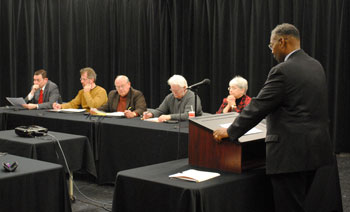Ann Arbor 2012 Budget: Fire, Police
Editor’s note: The Ann Arbor city council has held two retreats to discuss the city’s FY 2012 budget – one in early December 2010 and another in early January 2011. A summary of the material covered in those retreats is provided in previous Chronicle coverage: “Ann Arbor: Engaging the FY 2012 Budget.”
Leading up to the city administrator’s proposed budget in April – for FY 2012, beginning July 1, 2011 – the city council is also holding a series of work sessions on the budget. Their typical scheduling pattern is for the weeks between council meetings. Previous work sessions have taken place on community services as well as the 15th District Court. On Feb. 14, 2011, the council held its budget work session on safety services – fire and police. Also included were a raft of smaller departments – finance, information technology, mayor and council, administrator’s office, clerk’s office and Community Television Network (CTN). One budget work session remains, for the public services area, on Feb. 28.

At the podium is Barnett Jones, chief of police and head of public safety services for the city of Ann Arbor. Seated at the table, from right to left are: Marcia Higgins (Ward 4), Mike Anglin (Ward 5), Tony Derezinski (Ward 2), Stephen Kunselman (Ward 3) and Stephen Rapundalo (Ward 2). (Photo by the writer.)
On Feb. 14, heads of Ann Arbor’s police and fire departments presented the city council with their strategy for meeting budget reduction targets for the next two fiscal years – FY 2012 and FY 2013. They each presented their strategies for meeting the target on two different scenarios: (1) a 2.5% reduction for each year’s projected expenses; and (2) a 4.0% reduction for each year’s projected expenses.
Police chief Barnett Jones, who’s also head of all safety services for the city, told councilmembers he’d prefer to be “wrassling with a bad guy” instead of talking about the scenarios, but sketched out his reduction strategies anyway: On the 4.0% scenario, two years from now the department would have 14 fewer police officer positions than it does now – the force would decrease from 124 to 110 officers. Of the 14 police officer positions that could be eliminated, 13 of them would come through layoffs. That doesn’t include six additional, non-officer positions that would be eliminated in the department, four of them through layoffs.
Fire chief Dominick Lanza, who announced his resignation the day after the work session was held, sketched out a similar picture for the fire department: On the 4.0% scenario, two years from now, the department would have 13 fewer firefighters, with 11 of those reductions achieved through layoffs.
At the council’s first budget retreat, city administrator Roger Fraser and the city’s CFO Tom Crawford indicated that the 2.5% scenarios depend on unresolved union contracts settling with no salary increases and the adoption of the city’s new benefits plan. But even those scenarios would, in the first year of the two-year plan, result in the elimination of three police officer positions (two through layoffs) and five firefighter positions (three through layoffs).
The 2.5% target is the baseline reduction for all city departments, with higher targets established for a department (up to 4.0%) depending on how many of the department’s workers are on the new city benefits plan. The new plan requires higher contributions from employees for health care and pensions.
Besides fire and police protection, the city council received reduction reports from smaller departments, including a group of units in the finance department, the administrator’s office and the clerk’s office. They also discussed how the information technology department works out of a service fund that is external to the general fund. [Full Story]



